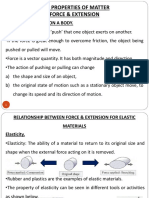0% found this document useful (0 votes)
27 views2 pagesDS Lesson 9
The document discusses the force-extension graph, illustrating how the extension of a spring varies with applied force according to Hooke's law. It explains that beyond a certain point, the spring becomes permanently deformed, and the graph's gradient represents the spring constant. Additionally, it covers the calculation of elastic potential energy and work done during stretching, along with exercises related to these concepts.
Uploaded by
lovejoyCopyright
© © All Rights Reserved
We take content rights seriously. If you suspect this is your content, claim it here.
Available Formats
Download as PDF, TXT or read online on Scribd
0% found this document useful (0 votes)
27 views2 pagesDS Lesson 9
The document discusses the force-extension graph, illustrating how the extension of a spring varies with applied force according to Hooke's law. It explains that beyond a certain point, the spring becomes permanently deformed, and the graph's gradient represents the spring constant. Additionally, it covers the calculation of elastic potential energy and work done during stretching, along with exercises related to these concepts.
Uploaded by
lovejoyCopyright
© © All Rights Reserved
We take content rights seriously. If you suspect this is your content, claim it here.
Available Formats
Download as PDF, TXT or read online on Scribd
/ 2





























































